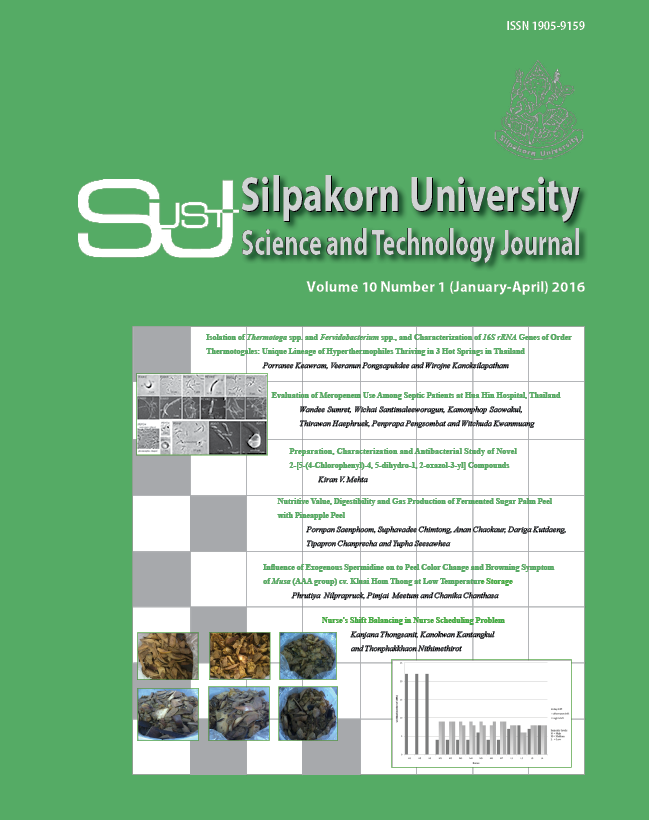Nutritive Value, Digestibility and Gas Production of Fermented Sugar Palm Peel with Pineapple Peel
Main Article Content
Abstract
An experiment was conducted to examine the nutritive value, digestibility and gas production of fermented sugar palm peel with pineapple peel. The treatment was conducted as a 3×2 factorial in a completely randomized design (CRD). The experiment consisted of six treatment combinations; sugar palm peel to pineapple peel ratios (2:1, 1:1 and 1:2 by weight) and fermentation times (day-14 and day-21). All treatment combinations were fermented under anaerobic condition in airtight plastic pouches. The result showed that ether extract content of fermented sugar palm peel with pineapple peel in 2:1 ratio at day-14 was significantly higher than other treatment combinations (P<0.05). Conversely, hemicellulose, acid detergent fiber (ADF) and acid detergent lignin (ADL) contents of fermented sugar palm peel with pineapple peel in 1:2 ratio at day-14 were significantly lower than other treatment combinations (P<0.05). The pH values were significantly different among treatment combinations (P<0.05). Overall, fermented sugar palm peel with pineapple peel at day-14 had lower pH value than those at day-21. In vitro dry matter digestibility of fermented sugar palm peel with pineapple peel in 1:2 ratio at day-14 were significantly higher than other treatment combinations (P<0.05). On the other hand, the volume of gas production was significantly different at 12 hr, and was not significantly different among treatment combinations (P>0.05) thereafter (24 hr, 48 hr and 72 hr). Fermented sugar palm peel with pineapple peel in 2:1 ratio at day-21 recorded the highest gas volume (45.16 ml). Results of this study suggested that the fermented sugar palm peel with pineapple peel in 1:2 ratio at day-14 produced a lower fiber content and higher digestibility silage, making it a suitable silage for ruminant animal since high fiber content had adverse effect on the nutrients digestibility.
Downloads
Article Details
References
Bartholomew, D. P., Paull, R. E., and Rohrbach, K. G. (2003). The pineapple: Botany, production and uses. London: CABI Publishing.
Bureenok, S. (2011). Applying fermented juice of epiphyticlactic acid bacteria (FJLB) as a new additive in tropical crop silages. Khon Khaen Agriculture Journal, 39: 85-98. (in Thai)
Ketnawa, S., Chaiwut, P., and Rawdkuen, S. (2012). Pineapple waste: A potential source for bromelain extraction. Food and Bioproducts Processing, 90: 385-391.
Makkar, H. P. S., Blümmel, M., and Becker, K. (1995). Formation of complexes between polyvinyl pyrrolidones or polyethylene glycols and tannins, and their implication in gas production and true digestibility in in vitro techniques. British Journal of Nutrition, 73: 897-91
McDonald, P., Henderson, A. R., and Herson, S. J. E. (1991). The biochemistry of silage, 2nd Ed. Marlow, Engla: Chalombe Publications.
Müller, Z. O. (1978). Feeding potential of pineapple waste for cattle. World Animal Review. 25: 25.
Naknean, P., Meenune, M., and Roudaut, G. (2010). Characterization of palm sap harvested in Songkhla province, Southern Thailand. International Food Research Journal, 17: 977-986.
Pereira, E. S., Mizubuti, I. Y., Ribeiro, E. L. A., Neiva, J.N. M., and Pimentel, P. G. (2013). Estimative of the nutritional value of agroindustrial byproducts by using in vitro gas production technique. Semina: Ciencias Agrarias, 34(1): 391-398.
Rowghani, E., Zamiri, M. J., and Seradj, A. R. (2008). The chemical composition, rumen degradability, in vitrogas production, energy content and digestibility of olive cake ensiled with additives. Iranian Journal of Veterinary Research, 9(3): 213-221.
Rungrodnimitchai, S. (2011). Novel source of pectin from young sugar palm by microwave assisted extraction. Procedia Food Science, 1: 1553-1559.
SAS. (1998). User’s Guide: Statistics, 9.2 ed. SAS Institute. Cary, NC.
Shultz, T. A., Ralston, A. T., and Shultz, E. (1974). Effect of various additives on nutritive value of ryegrass straw silage. I. Laboratory silo and in vitro dry matter digestion observations. Journal of Animal Science, 39:920-925
Sommart, K., Parker, D. S., Rowlinson, P., and Wanapat, M.(2000). Fermentation of characteristics and microbial protein synthesis in an in vitro system using cassava, rice straw and dried ruzi grass as substrates. Asian-Australasian Journal of Animal Science, 13(8): 1084-1093.
Sruamsiri, S., Silman, P., and Srinuch, W. (2007). Agro-industrial by-products as roughage source for beef cattle: Chemical composition, nutrient digestibility and energy values of ensiled sweet corn cob and husk with different levels of Ipil-Ipil leaves. Maejo International Journal of Science and Technology, 1:88-94.
Steel, R. G. D. and Torrie, J. H. (1980). Principles and Procedures of Statistic a Biometrical Approach, 2 nd Ed, New York, US: McGrow-Hill.
Suksathit, S., Wachirapakorn, C., and Opatpatanakit, Y. (2011). Effects of levels of ensiled pineapple waste and pangola hay fed as roughage sources on feed intake, nutrient digestibility and ruminal fermentation of Southern Thai native cattle. Songklanakarin Journal of Science and Technology, 33(3): 281-289.
Van Soest, P. J., Robertson, J. B., and Lewis, B. A. (1991). Methods for dietary fiber, neutral detergent fiber and non-starch polysaccharides in relation to animal nutrition. Journal of Dairy Science, 74: 3583-3597.
Yahaya, M. S., Goto, M., Yimiti, W., Gamo, Y., Kim, W., Karita, S., and Smerjai, B. (2004). Epiphytic microbiota on tropical Tinaroo legume (Neonotonia wightii) as revealed by denaturing gradient gel electrophoresis (DGGE) and scanning electron microscopy (SEM) and their effects on silage fermentation and ruminal degradability. Journal of Animal and Veterinary Advances, 3: 339-347.


